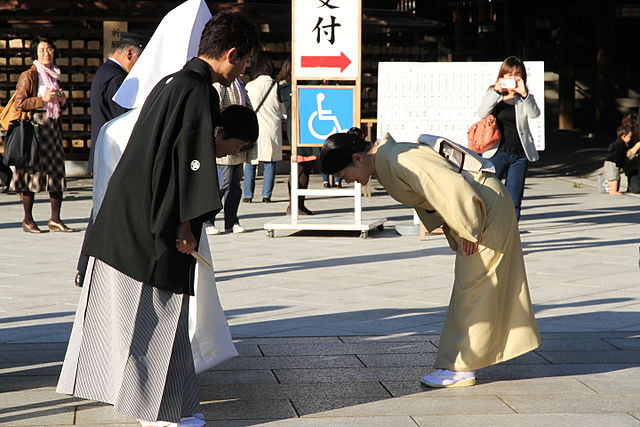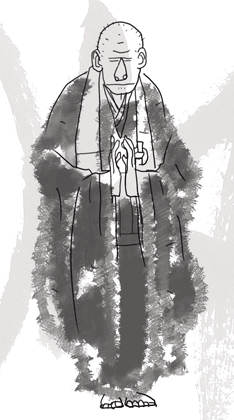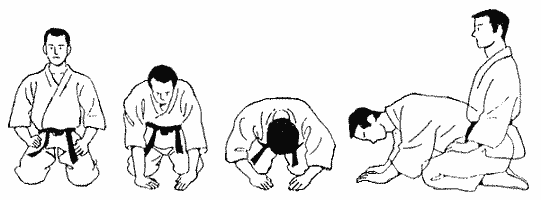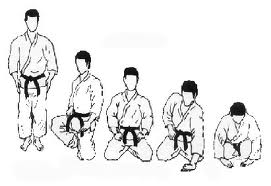by Steve Sharp
Sandan
The way of showing respect and gratitude with the right attitude.
Bowing in Japan has evolved into an everyday unconscious way of greeting within Japanese cultural norms but layered with hidden meaning in dependence on the person and place you are showing your respect and gratitude toward.
In normal every day life greeting would be via a standing bow where depth of bow is determined by the relationship you have with person or place.
The kneeling seated bow is normally only performed in Buddhist Temples Shinto Shrines and other Japanese cultural institutions to include the Arts and Ways.
Budo has maintained the ritual and dignity of the bow to demonstrate in practice the heartfelt respect and gratitude felt for the gift received of one’s chosen Art or Way from bowing to the Dojo the Founder the Sensei and one’s training partner for example.
Before discussing the deeper significance of the bow in our practice of Aikido let’s just look at the every day standing bow in Japan.


Looking at the picture above you will see three depths of bow each corresponding to a specific relationship between bowers ranging from a more intimate meet and greet situation to a more formal bow determined by a persons status.The more respect and gratitude one feels the deeper the bow.
Below you will also see some old pictures showing bowing in different contexts.

Here is also a photo and short pictorial video of the deep seated bow performed by a Buddhist monk.Notice how the monk lifts his hands which is a symbolic gesture of lifting the Buddhas feet above your head as a sign of deep gratitude and respect.

As you can see from the pictures shown Bowing is performed in many different contexts in Japanese society.
Now let’s look at the significance of bowing in Aikido.
First study the pictures and explanation seen below…

Putting both hands down at the same time

Putting the left hand down first

Getting into kneeling (seiza) position from yoi (masubi dachi)
The standing and seated Bow is an integral part of our practice in Aikido and one could argue that the Bow frames the whole practice given that we start and end our practice with it as a sign of respect and gratitude.
The Bow has to be embodied from the heart/mind with real meaning and significance to look and feel authentic from within and without.This will only come when the heart/mind of the individual recognises and values the Art/Way he is being taught with respect and gratitude in the knowledge and eventual awareness in appreciation of the gift.
The starting attitude of the bow is one of Humility Gratitude and Respect for all things animate and inanimate.This aligns specifically with the Shinto Way which sees Kami(Spirit)in all things.
Thus we bow on entering the Dojo as a sign of respect and care for the Place for the practice of The Way which in our case is Aikido.If the Sensei is already in the Dojo we bow to him respectful of the fact that he/she is our teacher.We also bow to our fellow Aikidoka’s in recognition of their value and appreciation of being in the Dojo for you to train with.If we handle a Jo or Bokuto we bow in a specific way in recognition of it containing the spirit of your years of practice.
You can see there are many instances where we get the opportunity to bow as an embodiment of a more enlightened attitude of Humility Gratitude and Respect for the wondrous opportunity we have to practice our Budo.
Let’s just briefly list the most regular bows.
A standing bow before entering the Dojo.
If the Sensei is already in the Dojo before practice and he catch’s your eye, bow.
If late for practice wait off the mats standing in shizentai or sitting Seiza off the mats and wait for Sensei to acknowledge your presence then bow enter the mats and perform a seated bow.
In unison with the Sensei a seated bow to the Shomen and O’sensei with a unified clap after the two bows(the clapping is used via a unified sound to clear and purify the space around us and within the Dojo).
Sensei then faces us and when he voices Onigaishimasu we rise from the seated bow to seated Seiza ready for practice.
After the practice session we repeat the above and then turn to our fellow Aikidoka’s and perform another seated bow.(This bowing is sometimes a little chaotic so important to make it clear with eye contact and body awareness who you are bowing to and not to lose form).After clearing the mats and exiting the Dojo…also bow to the Dojo on leaving.
You can see from the above how many times we get the opportunity to express our gratitude in body mind and spirit through the practice of our embodied and authentic bow. It forms and frames the very nature of our practice of Aikido from the start to the finish and beyond.
We have looked at the at the most obvious practice of the bow but there is a hidden aspect of the bow which runs through all Aikido from weapons to open hand techniques. This is something that has to be felt but if you look at pictures of Aikido you will hopefully spot the hidden bow throughout.
On a practical level this involves a slight degree of bend in the hip joint a sinking and settling into the hip crease a condensing into the front fascia and expansion of the back.This creates more power with less effort. This relates to the power of a full body Bow as opposed to a part body lever.
